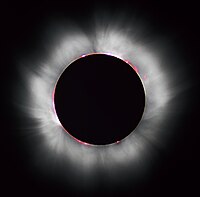
Photo from wikipedia
Solar flares with a fan-spine magnetic topology can form circular ribbons. The previous study based on H\alpha line observations of the solar flares during March 05, 2014 by Xu et… Click to show full abstract
Solar flares with a fan-spine magnetic topology can form circular ribbons. The previous study based on H\alpha line observations of the solar flares during March 05, 2014 by Xu et al. (2017) revealed uniform and continuous rotation of the magnetic fan-spine. Preliminary analysis of the flare time profiles revealed quasi-periodic pulsations (QPPs) with similar properties in hard X-rays, H\alpha, and microwaves. In this work, we address which process the observed periodicities are related to: periodic acceleration of electrons or plasma heating? QPPs are analysed in the H\alpha emission from the centre of the fan (inner ribbon R1), a circular ribbon (R2), a remote source (R3), and an elongated ribbon (R4) located between R2 and R3. The methods of correlation, Fourier, wavelet, and empirical mode decomposition are used. QPPs in H\alpha emission are compared with those in microwave and X-ray emission. We found multi-wavelength QPPs with periods around 150 s, 125 s, and 190 s. The 150-s period is seen to co-exist in H\alpha, hard X-rays, and microwave emissions, that allowed us to connect it with flare kernels R1 and R2. These kernels spatially coincide with the site of the primary flare energy release. The 125-s period is found in the H\alpha emission of the elongated ribbon R4 and the microwave emission at 5.7 GHz during the decay phase. The 190-s period is present in the emission during all flare phases in the H\alpha emission of both the remote source R3 and the elongated ribbon R4, in soft X-rays, and microwaves at 4--8 GHz. We connected the dominant 150-s QPPs with the slipping reconnection mechanism occurring in the fan. We suggested that the period of 125 s in the elongated ribbon can be caused by a kink oscillation of the outer spine connecting the primary reconnection site with the remote footpoint. The period of 190 s is associated with the 3-min sunspot oscillations.
Journal Title: Astronomy and Astrophysics
Year Published: 2020
Link to full text (if available)
Share on Social Media: Sign Up to like & get
recommendations!